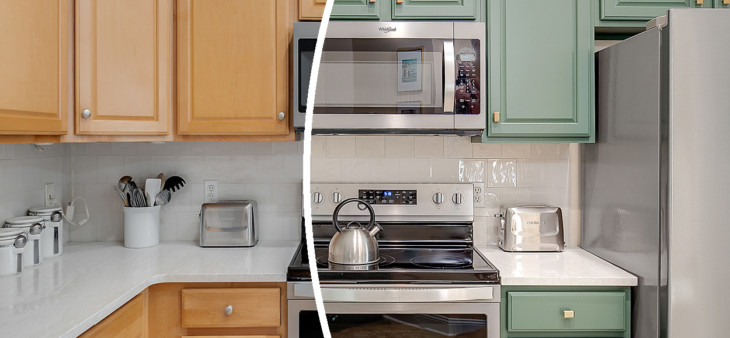Repainting your kitchen cabinets is a simple, affordable way to make a big change in your space. However, the process takes more than hard work, it also requires time and patience. To achieve the most successful outcome, avoid these common mistakes when repainting your kitchen cabinets.
Prepping Mistakes on Kitchen Cabinets
Taking the time to prep is key to successful kitchen cabinet repainting. This includes avoiding the following:
Keeping Doors & Drawer Fronts in Place
If you paint with the doors and drawer fronts in place, you’ll have a hard time reaching corners and other tight spots. It can also cause drip marks and other imperfections. Likewise, paint can get onto the hinges, which will make the final results look sloppy and unprofessional.
Forgetting to Organize & Label
Another common kitchen cabinet repainting misstep is not keeping track of all the hardware, like hinges and screws, as well as forgetting to number your drawer fronts and doors. This will make the installation process incredibly difficult and time-consuming.
Not Cleaning Cabinets Properly
If you don’t clean the cabinet doors, drawer fronts and boxes thoroughly with the proper cleaning solution, primer and paint won’t stick as well. Even if your cabinets look clean, still wipe them down diligently and rinse them thoroughly. Anything from food splatter to oil, water, and small dust particles could get in between you and a beautiful-looking finish.
Not Fixing Scratches & Holes
Now’s the time to deal with any imperfections on the surface of your doors and drawer fronts, as well as your cabinet boxes. Even if you repaint your kitchen cabinets, flaws will still be noticeable under the new finish, especially if you opt for a glossier sheen.
Not Creating a Dedicated Space to Paint
Don’t paint inside your home. Fumes will get irritating, plus splatter could damage surfaces, such as your floors and cabinet boxes. Plus, without a dedicated space for your cabinet doors and drawer fronts to dry, the whole process will take far longer and cause a lot more inconvenience in your life.
Sanding Mistakes on Kitchen Cabinets
Other common errors when repainting your kitchen cabinets involve sanding. If you don’t sand regularly, then you might want to practice ahead of time. Otherwise, it’s easy to make a mistake that can impact the finish.
A few to avoid include:
Skipping Sanding Altogether
Just because the primer you purchased states that sanding isn’t necessary, don’t skip this step. If you don’t sand, imperfections will be noticeable. It’s also more difficult for the primer and the paint to stick to the surface of the cabinets.
Sanding Inside Your Home
If you sand inside your home, you’re going to create a lot of dust that gets into the air and also sits on surfaces inside. It can take you months to find and clean up all the dust left behind since particles are so small and fine.
Not Cleaning After Sanding
Dust will not only get into the air and all over your home, but it will sabotage all your hard work if you don’t wipe it off the cabinet surface. Dust can also get into small crevices and corners on and in cabinets, then stick to them as the paint is drying. This will make your final finish look uneven and bumpy, especially in the light.
Priming & Painting Mistakes on Kitchen Cabinets
You’ve spent a lot of time prepping, sanding, and cleaning. Don’t drop the ball now and make these mistakes when it comes to priming and painting.
Not Priming
You might think you don’t need to prime because you’re repainting your kitchen cabinets the same or a darker color. This isn’t true. Paint adheres better to a properly primed surface.
If you don’t prime your cabinets, the finish won’t be as durable, which can lead to chipping and peeling once you start using your cabinets.
Using the Wrong Products
There are primer and painting products made for indoor and outdoor use, as well as for walls, furniture, and cabinets. Use the wrong one on your cabinets and it’s a recipe for disaster. Cabinet paint is designed to stand stronger because of heavy-duty use. This is critical in a busy kitchen environment if you want your paint job to last.
Painting with a Brush
Want a smooth, even finish when you’re done repainting your kitchen cabinets? Don’t use a brush. Otherwise, you’re going to wind up with visible stroke marks, as well as drips and other flaws you can see.
Post-Priming & Repainting Mistakes on Kitchen Cabinets
You’re almost to the finish line. Now is not the time to get sloppy by making these mistakes:
Not Allowing Enough Dry Time Between Coats
If you don’t allow each coat of primer and paint to dry thoroughly, before appling the next coat, bubbles can form due to the wet undercoating. Don’t mess up all your effort by moving too quickly and continuing with priming or painting before the prior coat is dry.
Re-Hanging Cabinets Before They’re Dry
Likewise, being too hasty to install your cabinet doors and drawer fronts is another common mistake. This results in smudge marks and imperfections on the newly painted surface that you’ll then have to touch up.
Next week, we’re covering how to fix these mistakes. Be sure to check back!
Ready to explore the many options for kitchen cabinet colors? Connect with N-Hance® and let us help! Call (855) 642-6230 to set up a FREE consultation.


